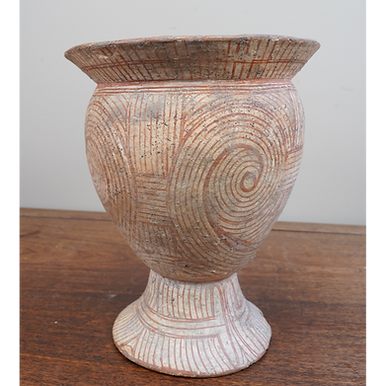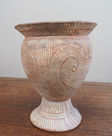80 - Ban Chiang Vase terracotta Thailand 1st to 3rd century
1000-2000 €

1st to 3rd century
Height: 27 cm Diameter: 20 cm
Northeast Thailand.
From the collection of a French family who attests to the existence of this vase in the family since the 1960s through various notarial successions in France. Acquired in an auction room and appraisedby Ban Chiang
Polychrome terracotta
The iconography, provenance, style, and surface examination of the piece, both macroscopic and microscopic, were very conclusive.TL QED laboratory QED 1947/BC-0803: 1900 to 2500 years old
Intermediate Period 1000 to 300 BC. The production of bronze objects has been documented since this intermediate period. The beautiful painted ceramics with red geometric patterns for which the site is famous date from the most recent period, from 300 BC to 300 AD. The site has been listed as a UNESCO World Heritage Site since
1992. The site is considered the most important known prehistoric settlement in Southeast Asia, marking the beginning and showcasing the development of wet rice cultivation. The site was occupied continuously from 1495 to 900 AD. The cultural complex is well-defined and distinct from anything that preceded it. This civilization provides the first evidence of a sedentary agricultural civilization in the region.
Climate change in the mid-first millennium led to the gradual abandonment of the site until the 17th century.
An originality of style and a lack of influence from its neighbors are noted. Bang Chian vases are not wheel-made. Even today, local potters continue to produce vases by turning the piece around. This explains their imperfection.
It is assumed that the geometrically shaped vases were probably produced only for funerary rituals, as evidenced by the particular care taken with this type of vase.
Our small vase is typical of the style.
Commission fees of only 20% + inhouse shipment available




